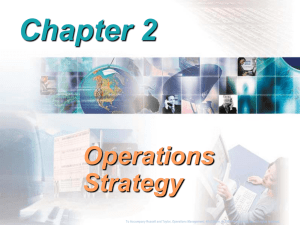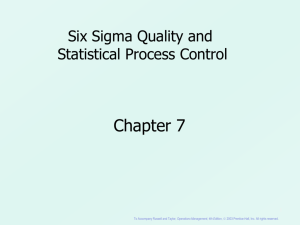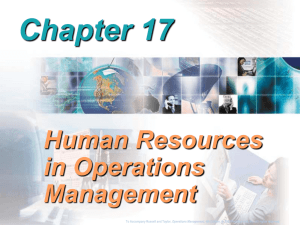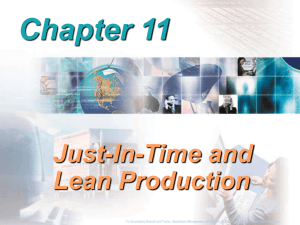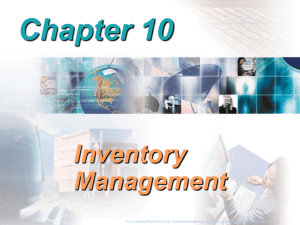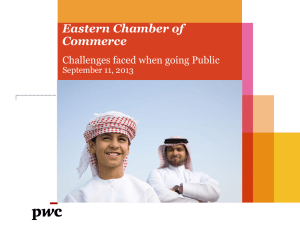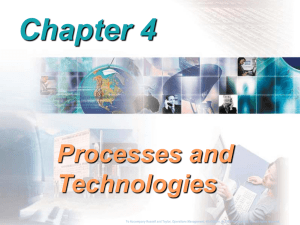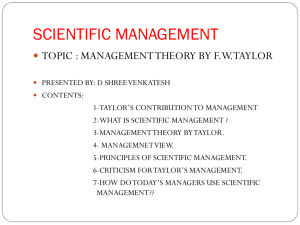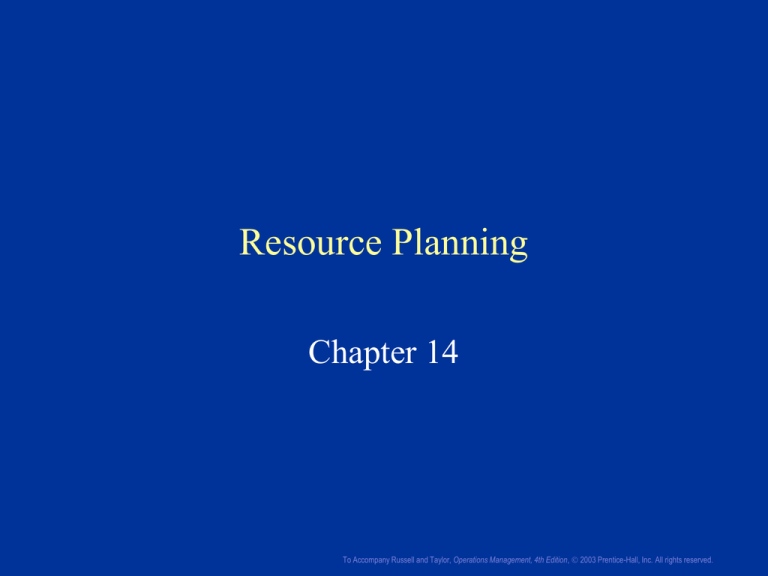
Resource Planning
Chapter 14
To Accompany Russell and Taylor, Operations Management, 4th Edition, 2003 Prentice-Hall, Inc. All rights reserved.
Why Resource Planning is Important
• To ensure that customer needs are met in the
most cost-effective manner, with the
required quality
• To take advantages of opportunities for
increasing profit through increased sales
and more cost-effective operations
To Accompany Russell and Taylor, Operations Management, 4th Edition, 2003 Prentice-Hall, Inc. All rights reserved.
Lecture Outline
• Why resource planning is important
• Material requirement planning (MRP)
– Why EOQ does not work for dependent demand
– When to use MRP
– How MRP works
• Capacity requirement planning
To Accompany Russell and Taylor, Operations Management, 4th Edition, 2003 Prentice-Hall, Inc. All rights reserved.
Lecture Outline (2)
• Enterprise Resource Planning
– What it is and why it is needed
• Who benefits most
– Customer relationship management, supply
chain management, and collaborative product
commerce
– Implementation, trends, and ERP systems for
small firms
To Accompany Russell and Taylor, Operations Management, 4th Edition, 2003 Prentice-Hall, Inc. All rights reserved.
Demand Characteristics
Independent demand
Dependent demand
100 x 1 =
100 tabletops
100 x 4 = 400 table legs
100 tables
Continuous demand
Discrete demand
400 –
300 –
No. of tables
No. of tables
400 –
200 –
100 –
1
2
3
Week
4
300 –
200 –
100 –
5
M T W Th F
M T W Th F
Figure 12.4
To Accompany Russell and Taylor, Operations Management, 4th Edition, 2003 Prentice-Hall, Inc. All rights reserved.
Material Requirement Planning (MRP)
Why MRP is Needed
• Using EOQ for dependent demand resulted
in parts shortages, higher overtime costs,
and late deliveries to customers
• MRP determines when parts and materials
are needed to meet a production schedule
To Accompany Russell and Taylor, Operations Management, 4th Edition, 2003 Prentice-Hall, Inc. All rights reserved.
Material
Requirements
Planning
Product
structure
file
Master
production
schedule
Material
requirements
planning
Item
master
file
Planned
order
releases
Work
orders
Purchase
orders
Rescheduling
notices
Master Production Schedule (MPS)
and Rough Cut Capacity Plan
• Master Production Schedule (MPS): shows
planned production by item, by day or
week, for 2 – 6 months
– Is revised as sales forecast changes
• Rough Cut Capacity Plan: a calculation to
ensure that there is enough capacity to make
the items in the Master Production Schedule
To Accompany Russell and Taylor, Operations Management, 4th Edition, 2003 Prentice-Hall, Inc. All rights reserved.
Databases Used in MRP Calculation
• Bill of material file: list of parts, raw materials,
and subassemblies for each finished good
– Quantity required for each item
• Inventory records file: amount of each finished
good, part, raw material, and subassembly in
inventory, plus amounts already ordered and
expected dates of receipt
To Accompany Russell and Taylor, Operations Management, 4th Edition, 2003 Prentice-Hall, Inc. All rights reserved.
Production and Purchase Planning
• A planned order specifies how much of an
item is needed, when it is needed, and when
it must be ordered to be available when
needed. Includes
– Purchase orders to outside suppliers
– Work orders for items made internally
• Planned orders are the key output from an
MRP system.
To Accompany Russell and Taylor, Operations Management, 4th Edition, 2003 Prentice-Hall, Inc. All rights reserved.
When to Use MRP
• Dependent demand
• Most useful for complex products
– Job shop production
– Assemble to order
To Accompany Russell and Taylor, Operations Management, 4th Edition, 2003 Prentice-Hall, Inc. All rights reserved.
Material Requirement Planning
• Based on a Master Production Schedule
• Schedules raw material and component part
delivery when they are needed to meet a
production schedule
• Designed to reduce inventory costs and improve
delivery reliability to customers
• Estimates available to promise (ATP) – amount
scheduled for production but not yet committed to
a booked order
To Accompany Russell and Taylor, Operations Management, 4th Edition, 2003 Prentice-Hall, Inc. All rights reserved.
Capacity Requirement Planning
• A check on the feasibility of the Capacity
Requirement Plan
• Identifies work centers with insufficient capacity
or insufficient work
– Production schedule and MRP should be revised
To Accompany Russell and Taylor, Operations Management, 4th Edition, 2003 Prentice-Hall, Inc. All rights reserved.
Capacity Requirement Planning (CRP)
Workload Graph for Work Center 101
Used to Evaluate the Feasibility of the Master Production Schedule
To Accompany Russell and Taylor, Operations Management, 4th Edition, 2003 Prentice-Hall, Inc. All rights reserved.
Why Enterprise Resource Planning (ERP)
was Needed
• MRP is not flexible enough for rapid order
fulfillment
• Marketing, Operations, Accounting and Finance,
and Human Resources Management need to share
a common database
• Companies need to
– communicate rapidly with suppliers and customers
– share selected data with suppliers and customers
To Accompany Russell and Taylor, Operations Management, 4th Edition, 2003 Prentice-Hall, Inc. All rights reserved.
Enterprise Resource Planning (ERP)
• Organizes and manages a company’s
business processes by sharing information
across functional areas
• Connects with supply-chain and customer
management applications
• Facilitates transactions in foreign currencies
• Can assist firms with different legal
requirements in different countries
To Accompany Russell and Taylor, Operations Management, 4th Edition, 2003 Prentice-Hall, Inc. All rights reserved.
ERP Modules
To Accompany Russell and Taylor, Operations Management, 4th Edition, 2003 Prentice-Hall, Inc. All rights reserved.
Inter-Organizational Data Flows
Source: Adapted from Joseph Brady, Ellen Monk, and Bret Wagner, Concepts in
Enterprise Resource Planning (Boston: Course Technology, 2001), pp. 7–12
To Accompany Russell and Taylor, Operations Management, 4th Edition, 2003 Prentice-Hall, Inc. All rights reserved.
Connecting with Customers & Suppliers
• Customer relationship management
• Supply chain management
• Collaborative product commerce
To Accompany Russell and Taylor, Operations Management, 4th Edition, 2003 Prentice-Hall, Inc. All rights reserved.
Customer Relationship Management (CRM)
• Software that supports
– Marketing planning and execution
– Personalized marketing
– Customer service
To Accompany Russell and Taylor, Operations Management, 4th Edition, 2003 Prentice-Hall, Inc. All rights reserved.
Supply Chain Management (SCM)
• Software that plans and executes business
processes related to supply chains
• Includes
– Supply chain planning
– Supply chain execution
– Supplier relationships and information sharing
To Accompany Russell and Taylor, Operations Management, 4th Edition, 2003 Prentice-Hall, Inc. All rights reserved.
Collaborative Product Commerce (CPC)
• Software that
– Incorporates new product design and
development and product life cycle
management
– Integrates customers and suppliers in the design
process though the entire product life cycle
To Accompany Russell and Taylor, Operations Management, 4th Edition, 2003 Prentice-Hall, Inc. All rights reserved.
Collaborative Product Commerce (CPC)
Customer Relationship
Management (CRM)
Collaborative
Design
Collaborative
Product
Commerce
(CPC)
Product
Design
Collaborative
Manufacture
Manufacture
&
Delivery
DFMA
Collaborative
Design
Collaborative
Manufacture
Enterprise
Resource
Planning
(ERP)
Time to Customer
Time to Market
Customers
Suppliers
Figure 12.3
Supply Chain
Management (SCM)
To Accompany Russell and Taylor, Operations Management, 4th Edition, 2003 Prentice-Hall, Inc. All rights reserved.
Who Benefits Most from ERP?
• Firms that regularly share information with
suppliers and customers
• Firms that engage in international business
(sales, purchasing, manufacturing, or
services)
To Accompany Russell and Taylor, Operations Management, 4th Edition, 2003 Prentice-Hall, Inc. All rights reserved.
ERP Implementation Strategy
• Which business processes have the biggest impact
on customer relations?
• Which business processes would benefit the most
from:
– Internal integration
– Integration with suppliers or customers?
• Which processes should be standardized?
• Which system functions do you need?
To Accompany Russell and Taylor, Operations Management, 4th Edition, 2003 Prentice-Hall, Inc. All rights reserved.
ERP Implementation Details
•
•
•
•
•
Which vendor?
Which modules?
Internal server or external portal?
Implementation schedule – fit with business needs
Data accuracy
To Accompany Russell and Taylor, Operations Management, 4th Edition, 2003 Prentice-Hall, Inc. All rights reserved.
Trends in ERP Systems (ERP II)
• Modular systems – firms can choose the
applications they need
• Industry solutions – database & reports
tailored to a particular industry
• Open source code – firms can modify ERP
application software
To Accompany Russell and Taylor, Operations Management, 4th Edition, 2003 Prentice-Hall, Inc. All rights reserved.
ERP II for Small and Mid-sized Firms
• Packages tailored for small firms
– Smaller, simpler, less expensive than largescale ERP systems
– Lack some features
• On-demand ERP computing through
Internet portals
– Provided by ERP software companies or “thirdparty” vendors
To Accompany Russell and Taylor, Operations Management, 4th Edition, 2003 Prentice-Hall, Inc. All rights reserved.


